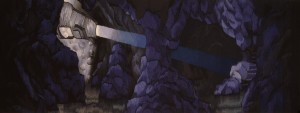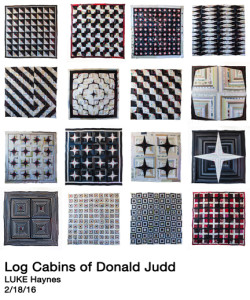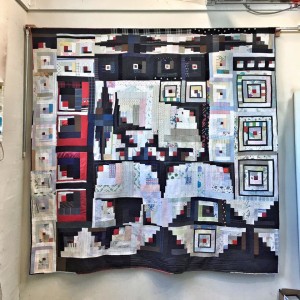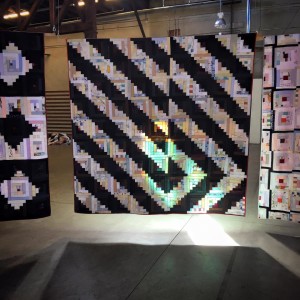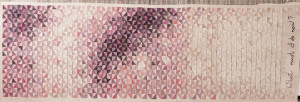50 amazing quilts on a theme
Quilter Luke Haynes first told us about his ‘Log Cabins of Donald Judd,’ exhibition plans almost six months ago when we featured him. Making 50, 90 inch square original quilts is not an easy task and we’re thrilled to say he’s done it!The log cabin is the first repeatable quilt block and the theme was inspired by the Donald Judd installation in Marfa at the Chinati foundation ‘100 untitled works in mill aluminum, 1982-1986.’ “The basic idea is that I have made 50 quilts iterations of the ‘log cabin’. All different variations with the same language, all red centres with white and black fabric,” Luke explains. “All the fabric is used textiles. so the patterns and language of the details are dictated by the range of ‘black,’ ‘white’ or ‘red’ that I have access to in the form of used garment/textiles. But will all read as graphic compositions in black and white.”
The exhibition has just finished at Crafted at the Port of Los Angeles in L.A but here are some images. Also the quilts are for sale through Luke. The plan is to take the exhibition around the world so we’ll keep you posted. Happy quilting.
Cool Collaborations
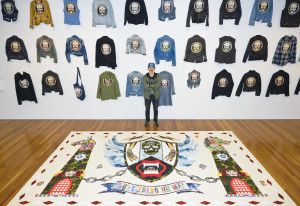
Collaborations between artists and fashion companies have been the norm for a while now, but it’s unusual to see artists who use textiles
which is what makes Ben Venom’s work with Obey Clothing all the more noticeable. Check out his range of t-shirts at www.obeyclothing.com/collections/ben-venom-artist-series.
There is also a great video to go with it explaining his inspiration and Ben working on one of his epic quits, take a look at our FB page.
Grayson Perry exhibition at Sydney’s MCA
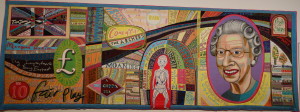
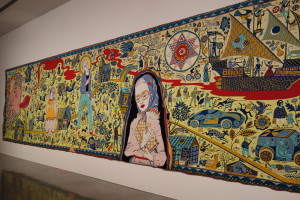
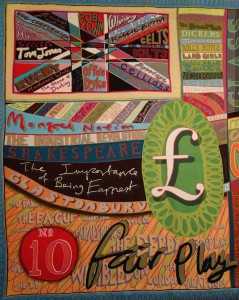
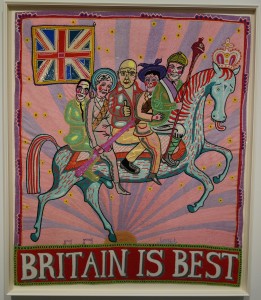
If you are anywhere near Sydney it is well worth a visit to the MCA to see ‘Grayson Perry – My Pretty Little Art Career.’It is the artists’ first major exhibition in the Southern Hemisphere and is a colourful collection of his ceramics, prints, paintings, sculptures, sketchbooks and of course his tapestries.Each of the nine tapestries is a visual feast of cultural, political and artistic references. If you missed his ‘The Vanity of Small Differences,’ exhibition, they are all here, as is the astonishingly huge 15 m ‘The Walthamstow Tapestry.’ It was also lovely to see the quirky ‘Britain is Best,’ which stood out to me as it is hand embroidered. It is a real treat to see textiles on such a large scale both physically and popularity wise. For more images visit our Pinterest page.
Grayson Perry – My Pretty Little Art Career runs until 1st May 2016.
February exhibition showcases three dynamic textile artists
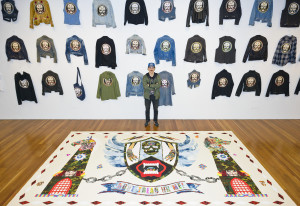
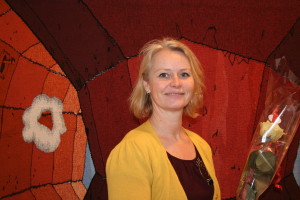
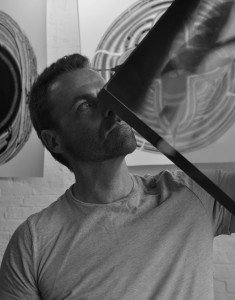
(Top image: Ben Venom in Kimball Gallery, photo by Randy Dodson)
Two of our artists this month take a look at popular culture. Quilter Ben Venom takes inspiration from music, tattoos and the occult, while Norwegian tapestry artist Kristin Saeterdal cites Science Fiction and computer games as part of her visual references. Using these as the foundation for their work brings textiles bang up-to-date and the vibrancy of their art leaves no question that the medium of textiles can have far more impact that just paint and a canvas.
Speaking of canvases, Philadelphia-based Matthew Cox uses the unlikely material of x-rays as his starting point. Proving that less is more, his careful stitching highlights the fast pace of technology and photography against the slow hand-made. We’ll be taking a further look at his new range of work ‘Fragmented Hosts,’ in an upcoming blog.
Video of 400 hours of tapestry weaving
For those of you from Australia, Happy Australia Day for January 26th.This week we have a video from fellow Australian textile artist Diana Wood Conroy.
She is in our current online exhibition and her tapestries take around 400 hours to complete.
For a glimpse of what 400 hours of tapestry weaving ‘What must I do now?’ (shown below) looks like,
visit our Facebook page or www.dianawoodconroy.com to watch the time lapse video.




